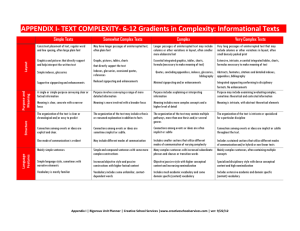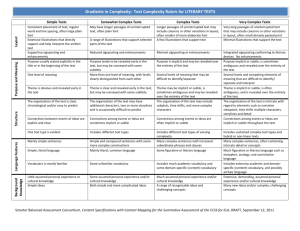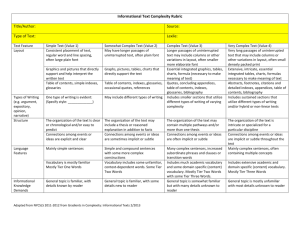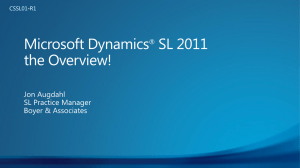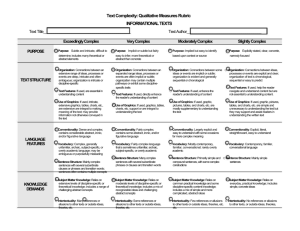Text Complexity Rubric for Informational Texts
advertisement
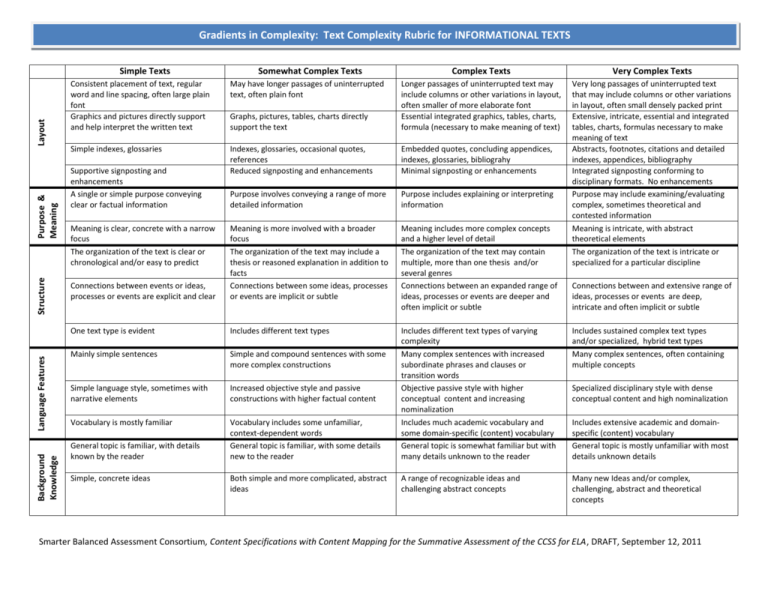
Gradients in Complexity: Text Complexity Rubric for INFORMATIONAL TEXTS Background Knowledge Language Features Structure Purpose & Meaning Layout Simple Texts Somewhat Complex Texts Complex Texts Very Complex Texts Graphs, pictures, tables, charts directly support the text Longer passages of uninterrupted text may include columns or other variations in layout, often smaller of more elaborate font Essential integrated graphics, tables, charts, formula (necessary to make meaning of text) Indexes, glossaries, occasional quotes, references Reduced signposting and enhancements Embedded quotes, concluding appendices, indexes, glossaries, bibliograhy Minimal signposting or enhancements Purpose involves conveying a range of more detailed information Purpose includes explaining or interpreting information Connections between events or ideas, processes or events are explicit and clear Meaning is more involved with a broader focus The organization of the text may include a thesis or reasoned explanation in addition to facts Connections between some ideas, processes or events are implicit or subtle Meaning includes more complex concepts and a higher level of detail The organization of the text may contain multiple, more than one thesis and/or several genres Connections between an expanded range of ideas, processes or events are deeper and often implicit or subtle Very long passages of uninterrupted text that may include columns or other variations in layout, often small densely packed print Extensive, intricate, essential and integrated tables, charts, formulas necessary to make meaning of text Abstracts, footnotes, citations and detailed indexes, appendices, bibliography Integrated signposting conforming to disciplinary formats. No enhancements Purpose may include examining/evaluating complex, sometimes theoretical and contested information Meaning is intricate, with abstract theoretical elements The organization of the text is intricate or specialized for a particular discipline One text type is evident Includes different text types Mainly simple sentences Simple and compound sentences with some more complex constructions Includes sustained complex text types and/or specialized, hybrid text types Many complex sentences, often containing multiple concepts Simple language style, sometimes with narrative elements Increased objective style and passive constructions with higher factual content Vocabulary is mostly familiar Vocabulary includes some unfamiliar, context-dependent words General topic is familiar, with some details new to the reader Includes different text types of varying complexity Many complex sentences with increased subordinate phrases and clauses or transition words Objective passive style with higher conceptual content and increasing nominalization Includes much academic vocabulary and some domain-specific (content) vocabulary General topic is somewhat familiar but with many details unknown to the reader Both simple and more complicated, abstract ideas A range of recognizable ideas and challenging abstract concepts Many new Ideas and/or complex, challenging, abstract and theoretical concepts Consistent placement of text, regular word and line spacing, often large plain font Graphics and pictures directly support and help interpret the written text May have longer passages of uninterrupted text, often plain font Simple indexes, glossaries Supportive signposting and enhancements A single or simple purpose conveying clear or factual information Meaning is clear, concrete with a narrow focus The organization of the text is clear or chronological and/or easy to predict General topic is familiar, with details known by the reader Simple, concrete ideas Connections between and extensive range of ideas, processes or events are deep, intricate and often implicit or subtle Specialized disciplinary style with dense conceptual content and high nominalization Includes extensive academic and domainspecific (content) vocabulary General topic is mostly unfamiliar with most details unknown details Smarter Balanced Assessment Consortium, Content Specifications with Content Mapping for the Summative Assessment of the CCSS for ELA, DRAFT, September 12, 2011
